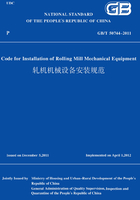
5.3 Mill Housing
5.3.1 Mill housing must be installed after the base plate is inspected and accepted.Drive side housing installation should be given priority,and then the housing on operation side should be installed.
5.3.2 Assembly requirements of mill housing and base plate(Figure 5.3.2)shall be in accordance with the following requirements:
1 Side face and plane of the joint surface of mill housing and base plate shall be tight enough.
2 Use 0.05mm feeler gauge for inspection and 75% of which shall be outside all around,and local clearance shall be less than 0.10mm.

Figure 5.3.2 Assembling of mill housing and rolling mill base plate
1-Mill housing;2-Rolling mill base plate
5.3.3 Installation of cross beam shall be in accordance with the following requirements:
1 After tightening cross beam and connection bolts,inspect the gap of contacting surface between cross beam and mill stand with 0.05mm feeler gauge,and 75% of which shall be outside all around,and it shall be taken as qualified.Local clearance shall be less than 0.10mm.
2 Tightness of connecting bolts shall meet the requirements of design.If there is no requirement from the design,it shall meet the requirements of current national standard,i.e.,"Generalcode for construction and acceptance of mechanical equipment installation engineering"(GB 50231).
5.3.4 Measurement of verticality for mill housing(Figure 5.3.4)shall be in accordance with the following requirements:
1 After assembling of mill housing and base plate,top and bottom cross beams,measure and adjust the verticality for mill housing window and mill housing side.
2 Verticality measurement for mill housing window shall be conducted on the lining board at exit section of two mill housing windows.
3 Side verticality for mill housing window shall be measured on inside or outside surface of mill housing at driving and operating sides.

Figure 5.3.4 Verticality measure for mill housing
1-Level meter;2-Plumbing;3-Heavy hammer
5.3.5 Levelness measure for mill housing(Figure 5.3.5)shall be in accordance with the following requirements:
1 Mill housing levelness shall bem easured on the bottom surface of mill housing windows at both drive side and operating side.
2 Longitudinal and horizontal levelness measurement for mill housing shall be conducted respectively at both drive and operating sides.
3 Relative levelness measurement for mill housing at both drive and operating sides shall be conducted.

Figure 5.3.5 Levelness measurement for mill housing
1-Millhousing;2-Base plate;3-Framed levelmeter;4-Long straight edge
5.3.6 Requirements for measuring surface skew status and level inclined degree of rolling mill housing opening(Figure 5.3.6)shall be in accordance with the following requirements:
1 Measure of surface skew status and level inclined degree of rolling mill housing openings shall take the centerline of mill train or the auxiliary line which is parallel to the mill train centerline as the reference.
2 Surface skew status and level inclined degree shall be measured on the side lining board at exit section of the two mill housing openings at drive and operating sides.

Figure 5.3.6 Measure for surface skew status and level inclined degree of mill housing opening
1-Millhousing;2-Base plate;3-Piano line parallel to rolling mill centerline
5.3.7 Measure of centerline deviation for the mill housing(Figure 5.3.7)shall be in accordance with the following requirements:
1 Take the rolling centerline as a reference to measure the rolling centerline deviation of mill housing.
2 Take the mill train centerline as a reference to measure the centerline deviation of mill housing train.

Figure 5.3.7 Rolling centerline deviation measure
1-Mill housing;2-Base plate;3-Center piano line of mill train;4-Piano line of rolling centerline
5.3.8 Parallelism of adjacent mill housings of tandem mill(Figure 5.3.8)shall be in accordance with the following requirements:

Figure 5.3.8 Parallelism measure for adjacent mill housings of tandem mill
1-Millhousing;2-Rolling mill base plate;3-Short straight edge;4-Inside micrometer
1 Tomeasure direction of parallelism for two adjacent mill housings of tandem mill,should take the middle rolling mill as a reference,and extend the measure to rolling mills at both sides.
2 To measure parallelism for two adjacent mill housings of tandem mill,should conduct the measurement on the exit side lining boards of two housing opening sat both drive and operating sides.
3 For adjacent mill housings located at both left and right sides of the intermediate rolling mill housing,its deviated direction of parallelism relative to the intermediate mill housing should be different.
5.3.9 Allowable deviation for mill housing installation shall be in accordance with those specified in Table 5.3.9.
Table 5.3.9 Allowable deviation for mill housing installation

Table 5.3.9(Continued)

5.3.10 Tightening of bolts shall be in accordance with the following requirements:
1 When hydraulic tension nut for stretching is used,the hydraulic pressure value of tension nut shall be calculated according to the designed fastening strength or fastening torque.
2 When the mechanical tightening method such as impacting and etc.is adopted,the elongation or nut rotation angle value shall be calculated after screw tightening according to the designed fastening strength or fastening torque.
5.3.11 Roll adjusting device shall be installed after completion of mill housing installation,fully tightening of anchor bolts and connection bolts for each parts of mill housings,and shall meet the requirements of design documents or current national standard,i.e.,"General code for construction and acceptance of mechanical equipment installation engineering"(GB 50231).
5.3.12 Allowable deviation for roll adjusting device installation shall be in accordance with those specified in Table 5.3.12.
Table 5.3.12 Allowable deviation for mill roll ad justing device installation
